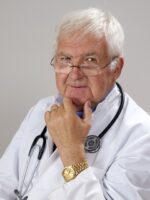 In a personal injury case one of the most important witnesses is the treating doctor. Here is my guide for direct examination of the treating doctor.
In a personal injury case one of the most important witnesses is the treating doctor. Here is my guide for direct examination of the treating doctor.
Meet the treating doctor before the direct examination. This needs to be done before the defense deposition. Cover client’s significant medical records including records that predate injuries at issue. Discuss any similar injury so the doctor is prepared to address it in the deposition and later during direct and cross examination. Discus the injury at issue.
As with all direct examination of a witness tell him what will be covered so he has a road map. Preparation is important but not at the expense of spontaneity. The direct examination is conversational rather than rehearsed. If it is being recorded remind doctor the camera is the jury.
In direct when in doubt stick to the six good friends: who, what, when, where, why & how questions. Rarely will you go wrong with this formula on direct. Make sure doctor is testifying on a more probable than not basis on opinions concerning nature and extent of injuries as well as conditions caused by event at issue.
Begin by asking the doctor why he is here today. The first minutes of the direct examination are the most important. Have doctor tell the jury he is plaintiff’s treating physician. He has been asked to testify on the injuries his patient sustained in the traumatic event, the course of treatment and how plaintiff is doing today.
Discuss Doctor’s background: Medical education, Association memberships, Board certification (include Teaching positions if applicable).
Discuss treatment of traumatically injured patients with similar injuries to plaintiff. Include questions about other areas of his medical practice. If doctor’s practice lacks a forensic component elicit this testimony. If there is a forensic component discuss the nature of this practice, and how it differs from a treating practice.
On treatment of client start with when he began treating client. If before injury what type of treatment. Cover pre- injury treatment or lack of treatment so jury hears pre-injury condition from you rather than defense during cross examination. On treatment for injury discuss initial subjective presentation, examination (covering objective findings), diagnosis (making sure more probable than not caused by injury mechanism), and treatment plan.
Illicit testimony on significant appointments. Cover subjective presentation and examination findings (which is objective evidence of injury). Cover referrals such as physical therapy and diagnostic studies. Elicit testimony on any significant medical record outside our doctor. Also have doctor explain significant diagnostic findings and how they were caused by the injury.
Unless waiving specials, have doctor testify all treatment he gave and referred is necessary to address client’s injuries. Get testimony that bills for necessary treatment are reasonable. Cover future medical care necessary to address continuing conditions as well as reasonable estimate of future medical costs.
Cover disability or impairment rating based on AMA Guidelines, impact on activities, impact on employment, pain and suffering (past, present, & future).
Conclusion. On a more probable than not basis is condition a result of the injuries sustained in our collision (causation). Discuss plaintiff’s history of subjective presentation being objectively consistent with subjective presentation. Discuss plaintiff’s dedication to recovery. End with future residuals being more likely than not.
Post Footer automatically generated by Add Post Footer Plugin for wordpress.


Inbound links exchange suggestion… Good day, how about exchange links with me at Learning English?. Better yet, I offer a three-way link directed from my another site. The swap link request info is on my home page.
Hyvin tehty ja keep it up! Olen ajatellut alkaa WordPress blog liikaa. Tiedatteko mitaan sivustoja, joissa ne opit?
Good Information… thank you for the information.
I really enjoyed this post. You explain Direct Examination of a Treating Physician very well. As treating doctors with Medical House Call we are turning back the clock. Medicine used to be practiced regularly on a personal level, before busy doctor’s offices, complicated insurance policies, long lines at clinics, rushed office visits, and crowded emergency rooms. Today many doctors have lost sight of what matters most- the patient. Doctor and patient need a truthful relationship which comes by taking the time necessary to discuss, examine, diagnose, and treat the condition. When our patient is injured and has a legitimate claim we need to cooperate with our patient’s lawyer. This means testifying. Your post helps to understand what will happen before and during direct examination.
Really appreciate you sharing this blog.Really looking forward to read more. Keep writing.
Im thankful for the blog article. Will read on…
The clearness of your post is spectacular. Your RSS feed will keep me updated with forthcoming posts. Thanks a million and please keep up the rewarding work.
Excellent post with some good info, think i’ll share this on my twitter if you don’t mind and maybe even blogroll it depending on the feedback, thanks for sharing